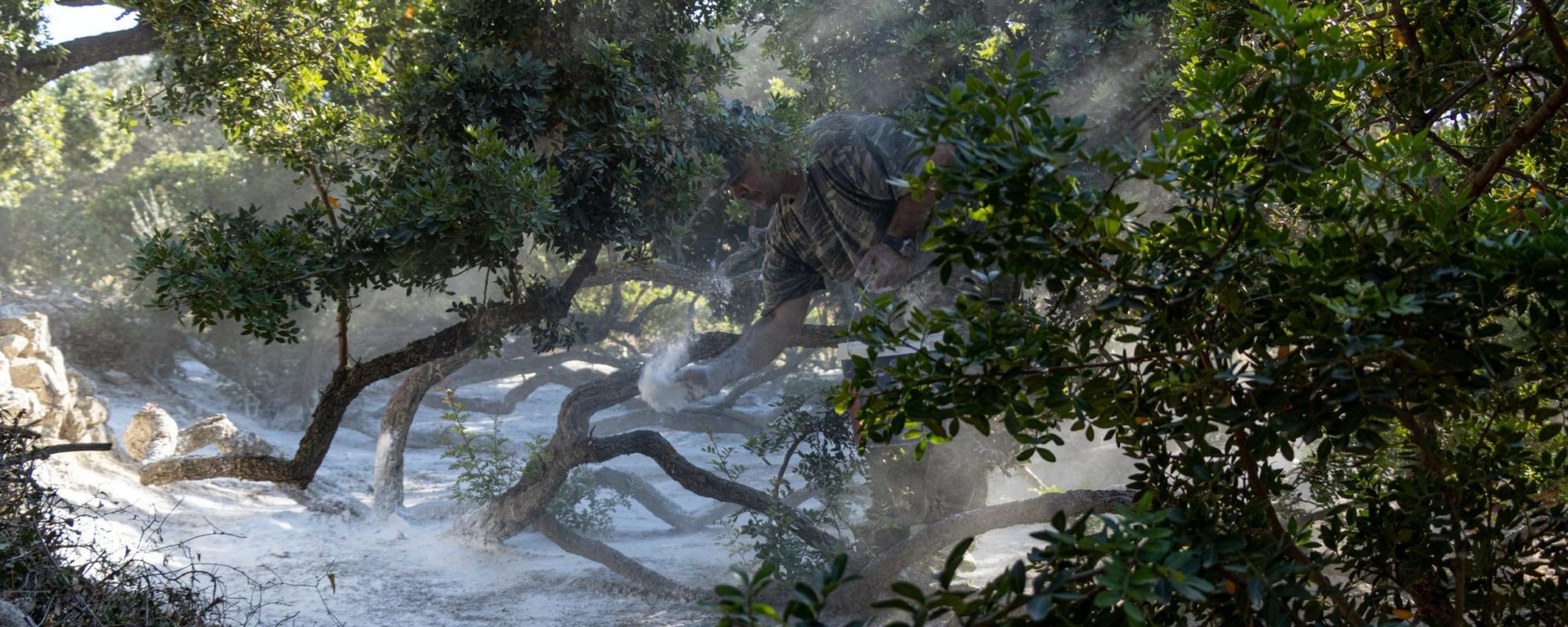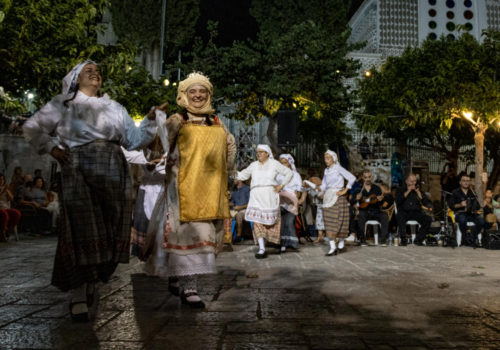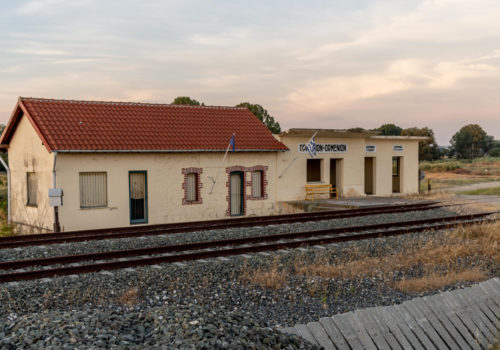OLYMPOI, Greece — When the sun sets, the grandmothers of Mastichochoria, the 24 mastic-producing villages of southern Chios, sit in plastic chairs outside their stone houses, watching everyone who comes and goes. As a boy who spent his summers on the island, my partner Andreas was always afraid of them. Dressed all in black, these wizened women guard their streets like sphinxes, detaining children and foreigners with their endless questions: “Who are you? What are you doing here? Where are you from? Who are your parents?”
Two of these curious old women apprehended me one evening while I was waiting to meet a friend, and after the usual, well-intentioned interrogation, they asked if I knew the story of Agios Isidoros, patron saint of the mastic tree (Pistacia lentiscus var. chia, or schínos in Greek). Isidoros served as a Roman naval officer on Chios around 250 CE. After confessing his Christian faith to Admiral Numerius, he was tortured and beheaded before a schínos tree, which received its share of blows. Legend has it that the saint’s martyrdom caused the tree’s wounds to weep, yielding the first mastic “tears.” Though the tree grows throughout the Mediterranean, it produces this thick, aromatic resin, the “miracle” of Agios Isidoros, only in southern Chios.
The exact reason for this site specificity is unknown, but scientists attribute it to three factors: first, a unique microclimate characterized by mild winters and hot, arid summers allows mastic tears to dry on contact with air; second, centuries of selective propagation privileged trees that created the most and best quality resin; third, organized commercial exploitation since the Middle Ages—and especially during Genoese rule in the 14th century—standardized the product and established wide demand for it as a luxury item.
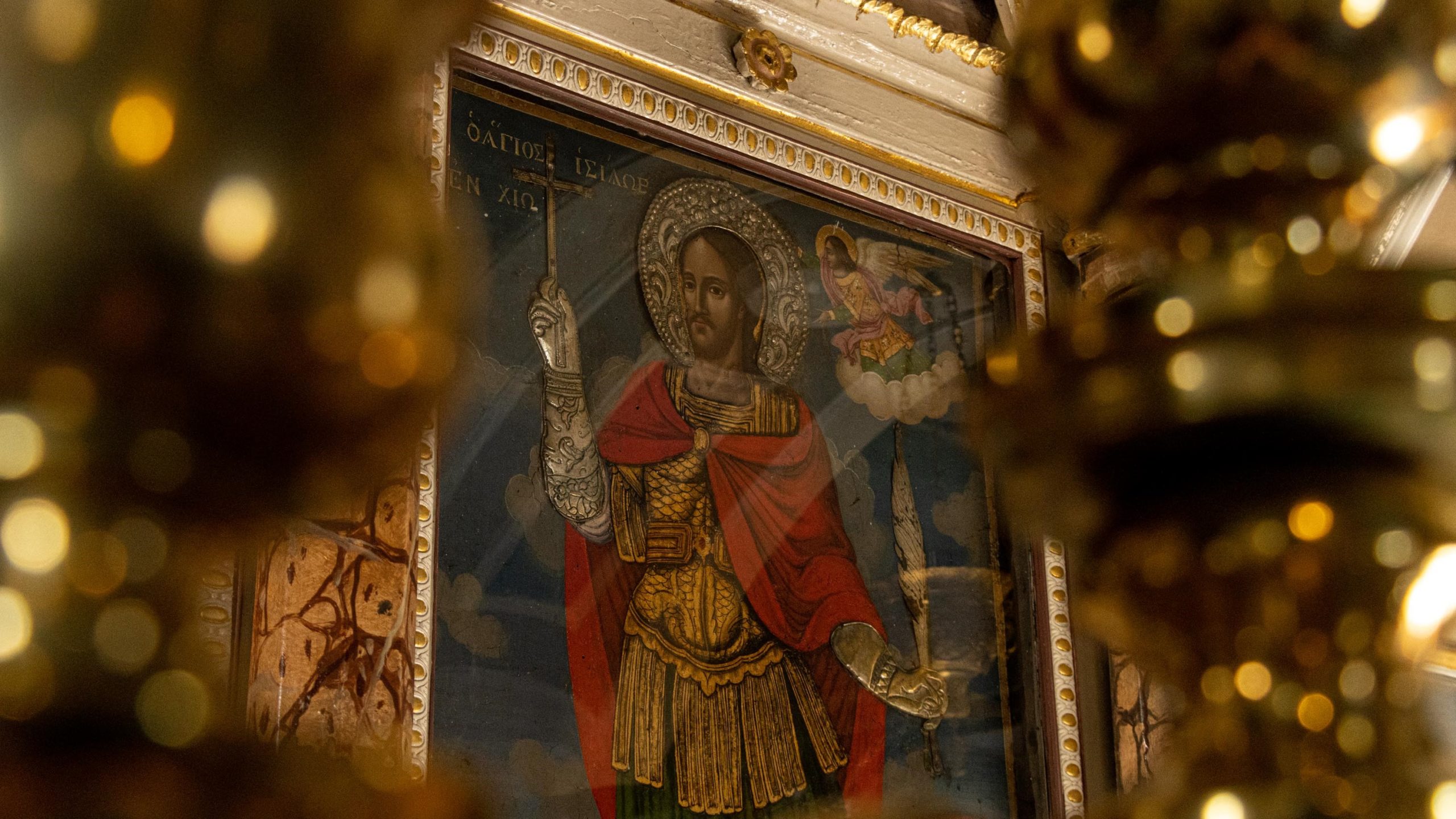
Mastic’s unique flavor and health benefits have been recognized since antiquity. In 77 CE, the Greek physician and pharmacologist Pedanius Dioscorides wrote in his encyclopedia of herbal medicines De Materia Medica that mastic is “good for the stomach,” useful in cleansing the face and promoting “skin radiance,” and “when chewed, helps scent breath and strengthen the gums.” Today, it is marketed as a health and beauty product, perfume, incense, cooking ingredient and chewing gum. Roughly 85 percent of production is exported to a total 55 countries, mainly to Saudi Arabia and the Middle East, but increasingly to South Korea and the United States.
On average, one kilo retails for 115 euros, and farmers earn 90 to 100 euros depending on the quality of their raw product. The Chios Gum Mastic Growers Association, the mandatory union for all producers on the island, has 4,500 registered members, 1,800 of whom are active. A majority cultivate mastic for secondary income, producing some 200 kilos per year and earning 20,000 euros. Dr. Ilias Smyrnioudis, general manager and head of research and development, told me the association’s annual turnover, including subsidiary companies that sell mastic products, is 35 to 40 million euros. Last year, it made 3 to 4 million euros in profit, which it shared with its growers.
Chios mastic, the “white gold of Greece,” is a Protected Designation of Origin (PDO) product in the European Union, and in 2014, the cultivation of the rare resin was inscribed on UNESCO’s Representative List of the Intangible Cultural Heritage of Humanity. While living in the medieval village of Olympoi and participating in the summer harvest, I learned that this arduous process is deeply woven into the culture and livelihood of Chios’s southern Mastichochoria. Now in the face of mounting climate challenges, mastic producers are experimenting with innovative techniques to meet demand and diversifying with new agrotourism endeavors.
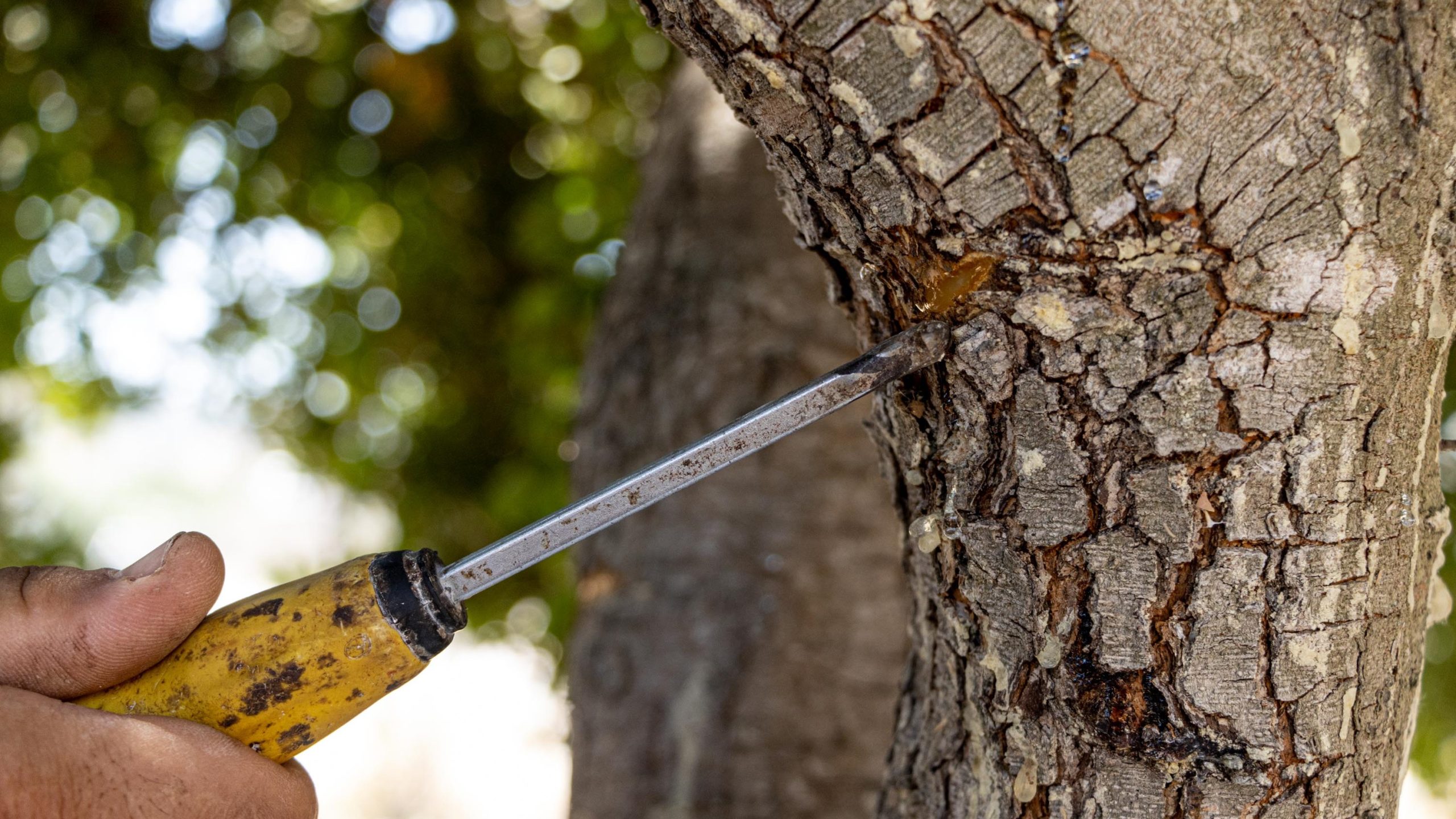
Summer as a mastic producer
Panagiota “Giota” Giannouri and her husband Christos Demiris were the first growers I met when I arrived on Chios in early July. Christos is the cousin of my friend Angeliki Demiri from Dadia in northeastern Greece, some 500 kilometers away, and he has the same stocky build and wide brow as his brother in the village. Like many men from Evros, he works as a soldier, and he and Giota supplement their income by harvesting mastic. We had coffee in the main square of Pyrgi, the largest of the medieval Mastichochoria, known for the geometric black-and-white patterns called xystá scratched into the façades of its buildings.
Mastic cultivation is a family affair, passed from one generation to the next. Giota’s father owns trees, and when she was a student, helped him with the summer harvest. She has been a professional producer since 2014. The couple owns 800 trees and made about 14,000 euros last year. Now they’re planting others. “The Mastic Museum depicts production in a very cinematic way,” Giota said. “You can’t get a sense of it unless you’re out in the fields.” I savored the subtly sweet, piney taste of mastic ice cream while they were describing the year-round cultivation process, one sometimes disputing what the other had just said, often speaking simultaneously.
The schínos is an evergreen shrub two to three meters high that thrives in the poor, stony soil of southern Chios. They are so hardy they don’t need to be watered after their first two summers. Trees begin weeping at five to seven years old. On average, they produce 150 to 200 grams per year, yielding the most between the ages of 15 and 50. Male trees are cultivated almost exclusively, as they have higher yields. Mastic subspecies range from village to village, differing in height, foliage and yield. It is so particular to this region that when the couple brought a tree to Dadia, it stopped producing.
Christos agreed to take me to the fields, and the next day I joined him on one of their small plots near the seaside village of Katarraktis. The mid-afternoon sun beat down, and I sought shade under a mastic tree, whose foliage formed an umbrella over its branches and trunk. Producers usually work from 6 a.m. to 11 a.m. to avoid the heat, but Christos wanted to finish preparing the soil around these trees for the start of harvest.
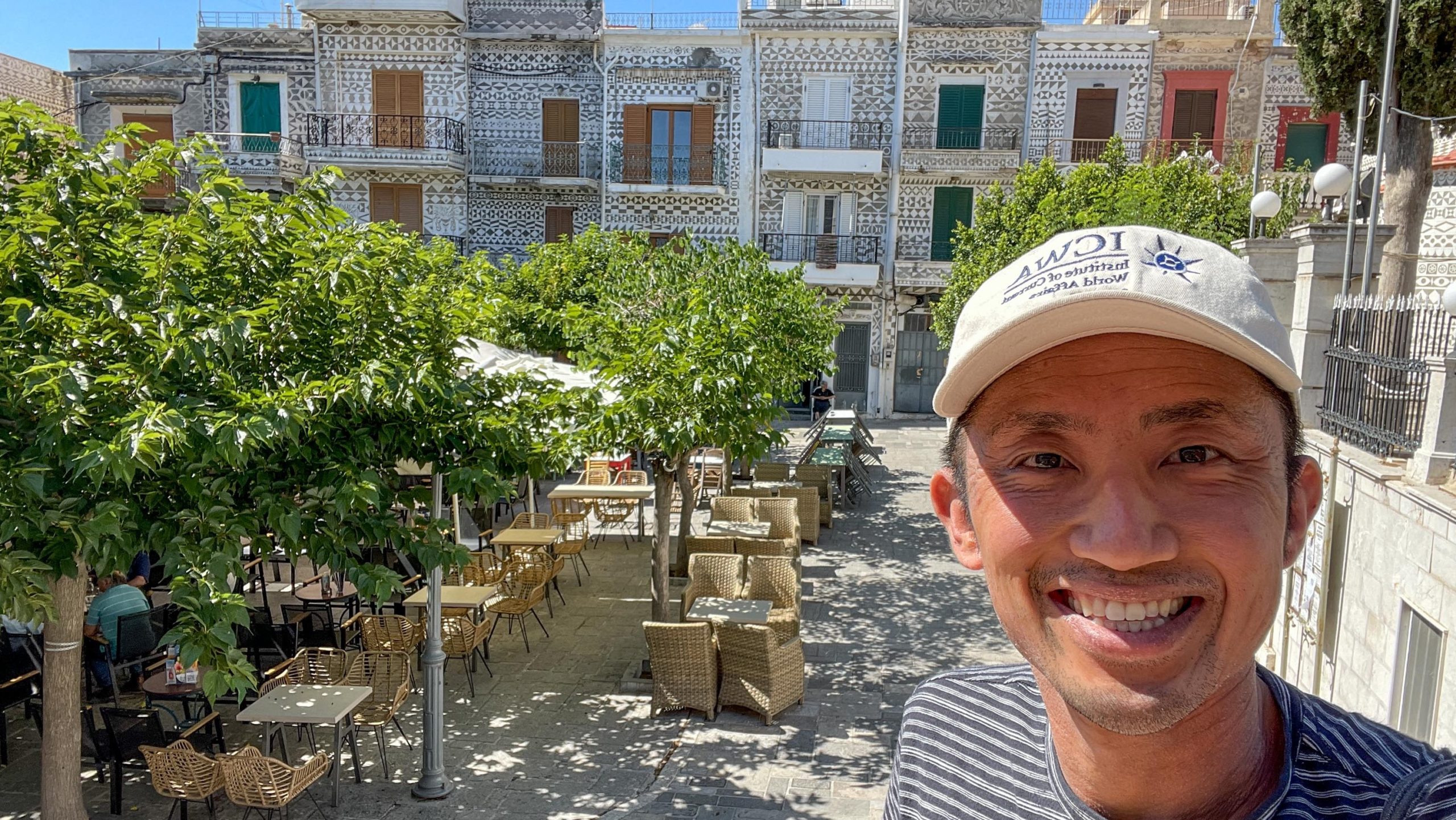
Mastic cultivation is still done in the traditional way, with minor modernizations. First, Christos cleared and leveled a circular area at the base of each trunk called the “table.” He pruned branches, uprooted weeds and removed leaves and rocks with a leaf blower until a circle of dry, compacted soil surrounded each tree. Then, with an iron tool called a kentitíri, he made quick incisions near the base of each trunk to “awaken” the tree and “remind it” to secrete mastic.
Finally, he covered the table with a white calcium carbonate powder provided by the mastic association. Powder flew up from the ground in white clouds, catching shafts of sunlight. Throughout the summer, mastic tears fall onto the table from cuts made in the branches and trunk. The white soil creates a clean surface for them to land and helps solidify and polish them, without affecting their quality. The better the table is tended, the easier it is to collect resin. Dressed head-to-toe in camo gear, Christos flung handfuls of powder, disappearing between the trees. I returned home covered in fine white dust.
From July through September, growers “wound” or “embroider” each tree once a week, slowly working their way up the trunk and across the thicker branches. That is considered the most important phase of cultivation. Producers make about 100 shallow incisions in the bark in total depending on the tree’s age and size, taking care not to injure it by cutting too deeply. Mastic flows from the wounds and begins to dry on the table 10 to 20 days after the first carving, based on the weather and size of the mastic pieces.
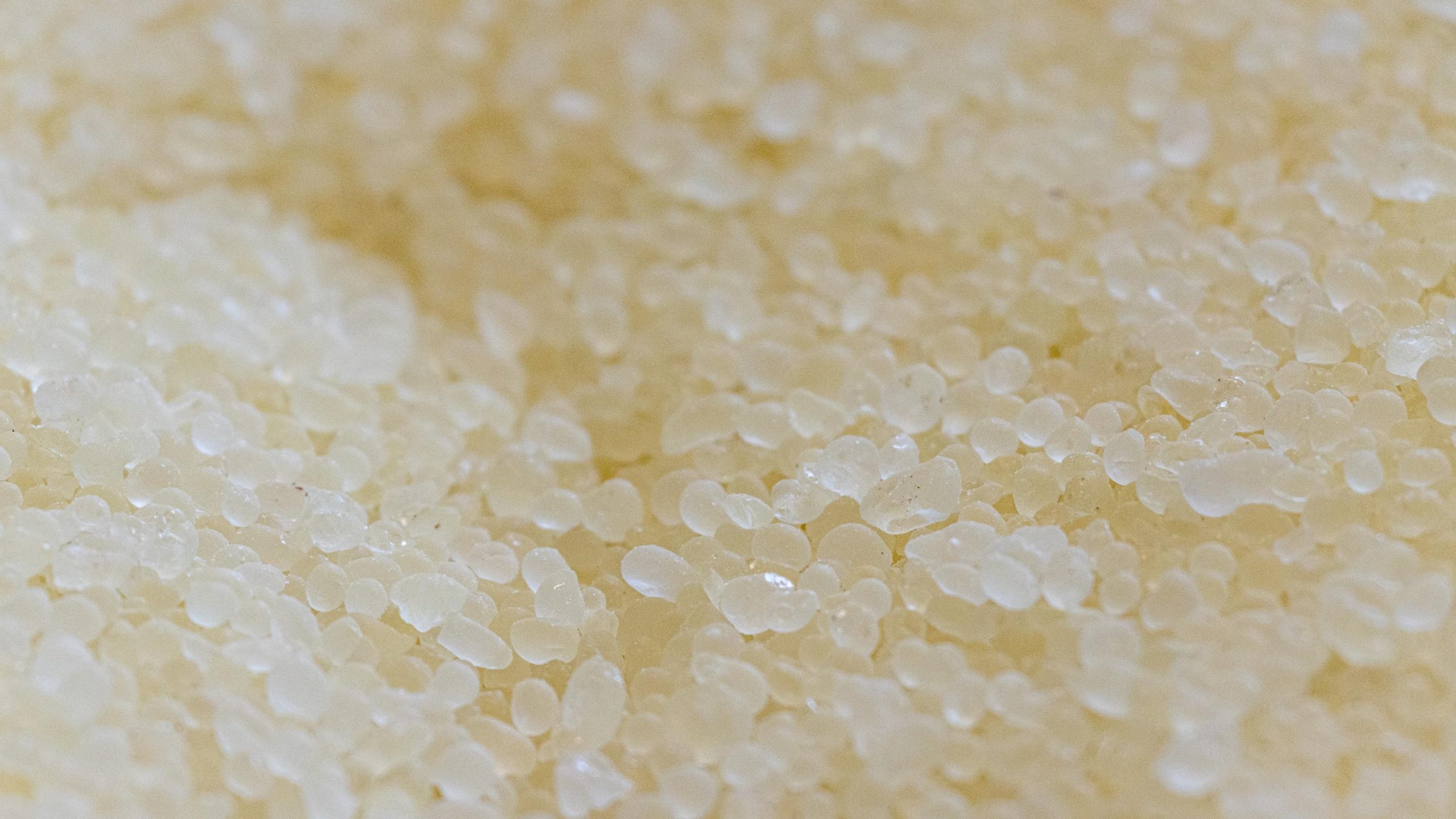
After the 15th of August, when the resin has had enough time to thicken, it’s time for the first collection. That is when producers gather large chunks of mastic called pítes, or “pies,” which are formed by resin secreted from cuts on the lower half of the trunk. Growers must collect these pieces early in the morning while they are hard. I joined another couple, Maria Gkanali and her husband Kostas Sokianos, before sunrise to gather pítes from their fields near Olympoi.
Maria grew up in Olympoi and has helped her mother and sister embroider trees since she was 12. She and Kostas have been cultivating mastic professionally since 2008. From 800 trees, they produced 130 kilograms of mastic last year and made about 13,000 euros. They expect a similar yield this year. Kostas also sells firefighter equipment in Chios Town and hunts partridges in the fall; Maria raises their two children. She told me all this in her rapid-fire Olympousis dialect as Kostas’s truck thumped over the rocky agricultural road to a plot of terraced schínos groves. “I bought this truck for hunting, and now it’s covered in mastic,” Kostas complained.
We suited up before leaving the truck: headlamps, gloves and sturdy knee pads for the hours we’d spend crouching under the trees. Maria wore a headscarf to keep the resin out of her hair. The fields were silent, and the smell of mastic hung in the cool air. Even the cicadas hadn’t started crying. Maria and Kostas collected pítes side by side, gently laying them into peach trays lined with newspaper and sprinkled with white powder. Maria kept a thorough accounting of how much mastic each field produced and knew exactly how many trays to bring. “We spend more hours together under the trees than at home,” she told me. Kostas went further, calling the trees his “other children” since he’d propagated and raised them.
Out among the trees, they joked and teased each other to make the work seem lighter. Maria tapped pítes with a kentitíri to see if they were solid. “Are you soft?” she asked the mastic. She set the largest pieces in a separate tray and sprinkled them with white soil in case they melted again. If a piece was gooey, she left it on the table to be collected later. If it had too much dirt or dead leaves stuck to it, she put it back on the tree so it would melt again and purify, saving her the hassle of having to clean it later. “You’ll always find an ant in your píta,” she assured me.
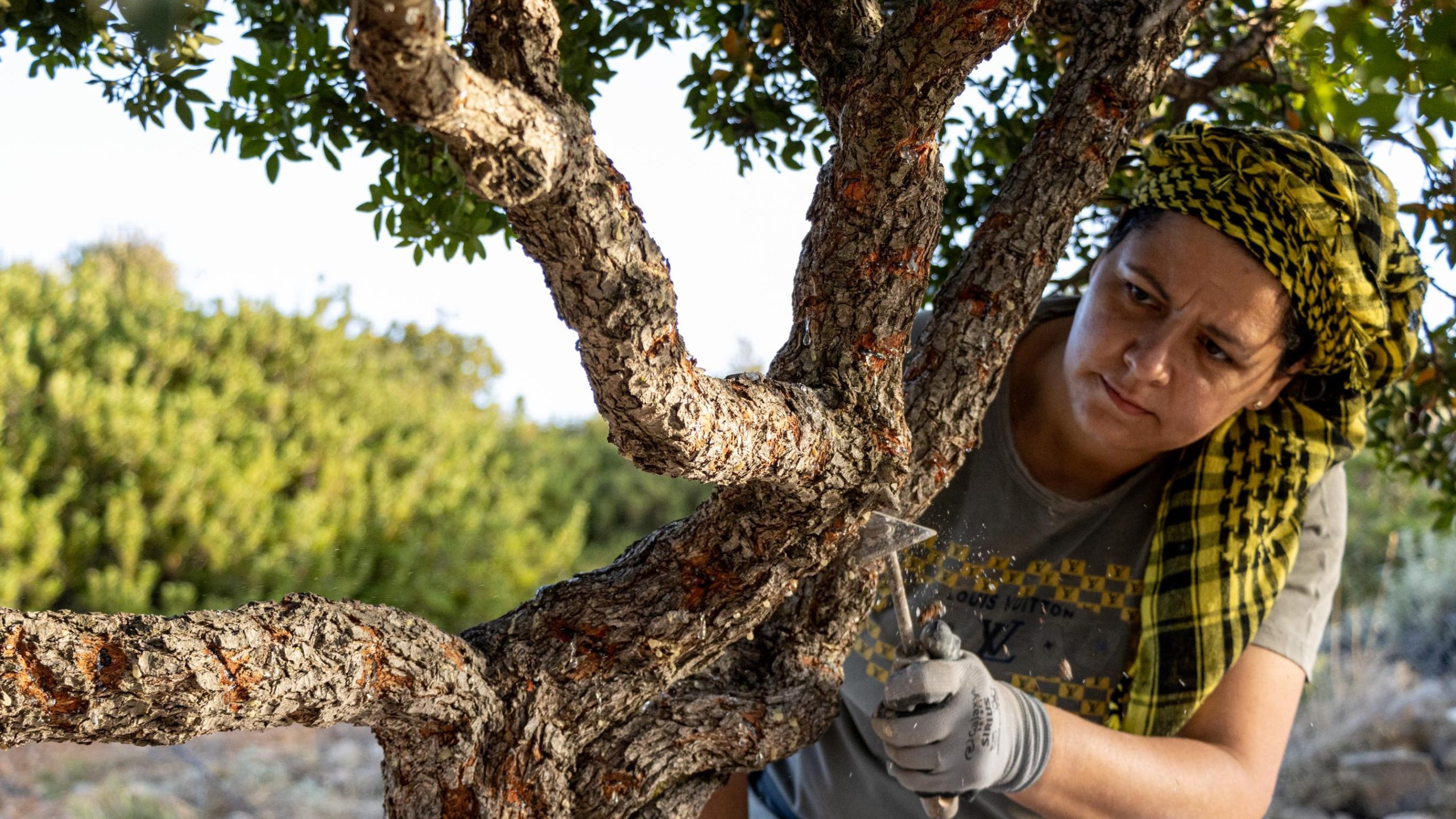
Nearby, Kostas shouted “Kamári mou levénti!” whenever he found an unusually large píta. The phrase means something like “my pride and joy,” except it refers specifically to the valor and physical prowess of a young man. “These are the pítes I like,” he said, handing me a fat, glassy piece to taste. “So clean you can deliver them straight to the cooperative.” It didn’t have a speck of dirt on it, just a bit of white powder where it had landed on the table. I put it in my mouth and tasted the distinct piney flavor, moving it from side to side to keep it from sticking to my teeth. Upon returning to Olympoi, Maria and Kostas stacked their trays in the family warehouse so the pítes could solidify further before being cleaned and washed.
In early September, producers embroider the upper half of the tree, followed by a second collection at the end of the month. This final phase of the harvest is slow and arduous. I accompanied Maria and Kostas to a field in Therides where she and her family had 320 trees. “You can easily embroider 400 trees and go to another field the same day,” she told me. “But the second collection takes much longer.” It was their second day gathering from this field. They said I was lucky not to have come the day before—they’d been plagued by heat and horseflies.
Although I didn’t see any foreign seasonal workers in the fields this summer, full-time growers who produce 400 to 500 kilos need workers 4 or 5 months of the year. Kostas mentioned that Pakistani workers in the southeastern mastic village of Nenita had recently departed to Lesvos for the olive harvest. They were paid 4 euros per hour to help with the collection. By contrast, Kostas paid a nursing student from Chios Town 11 euros for the same work.
Maria and Kostas scraped mastic tears from the branches and trunk of each tree with a metal tool called a timitíri. Some had solidified just as they were about to fall, frozen in place like tiny icicles. I touched them gingerly, surprised to find them hard. The couple worked on large trees together; most were over 200 years old. The tool made a satisfying sound as it knocked resin and bits of bark onto the table. “Láspi!” Kostas shouted in irritation when soft mastic stuck to his timitíri. They left this so-called “mud” to be collected when they prune the trees in winter.
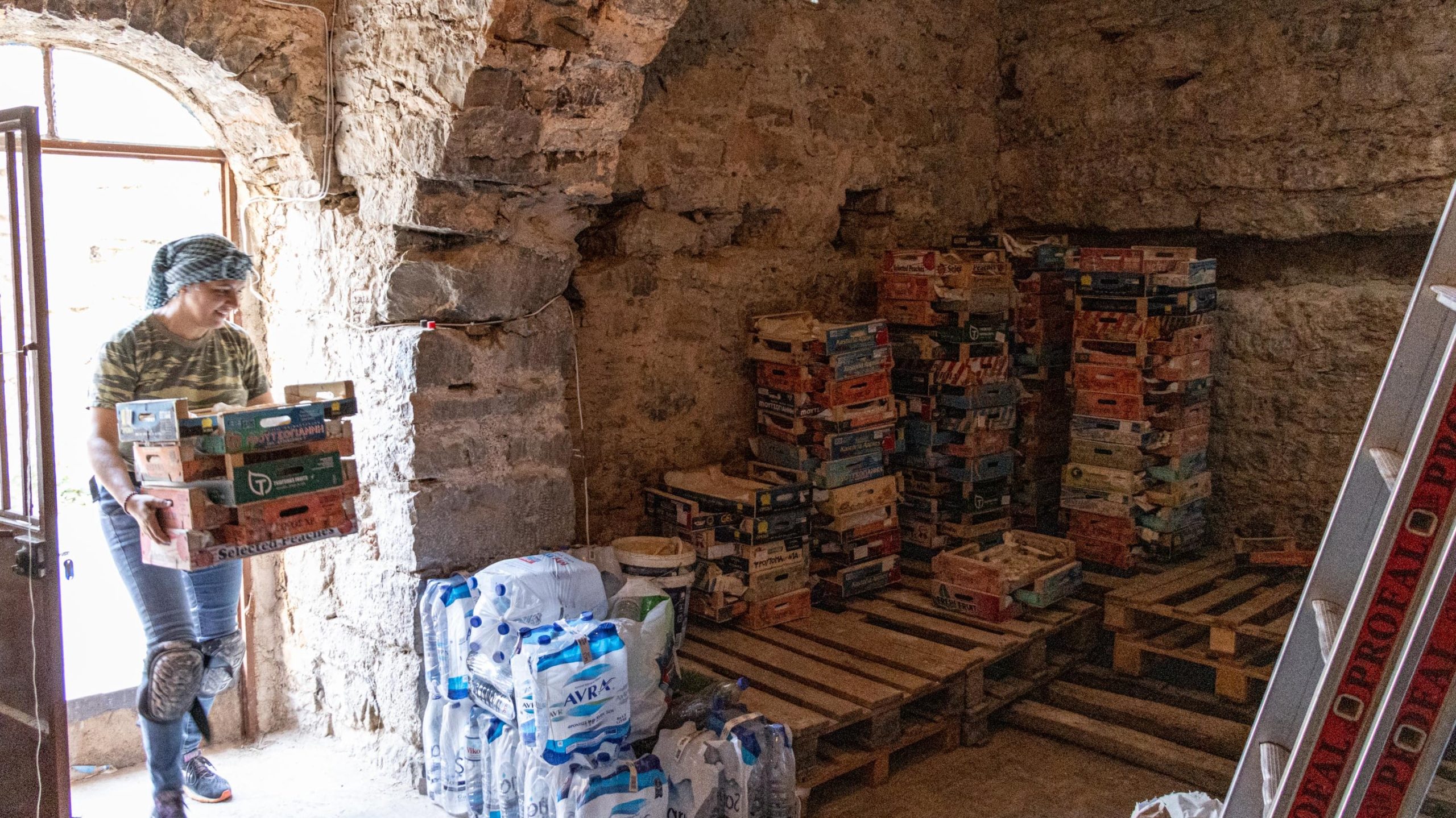
The morning wore on, and Kostas set the píta trays under his truck to keep them out of the sun. Mastic tears glittered like hardened dew drops under each tree. To ensure they gathered every drop, Maria and Kostas carefully swept up the table with a broom. They sifted the contents to remove the white soil and picked out the largest rocks and branches. Then they poured the remaining mix of leaves, twigs, rocks and resin into sacks and loaded them onto the truck bed.
Returning to the family warehouse after our day’s work, I was impressed by how much Maria and Kostas’s store of mastic had grown since my last visit roughly a month before. Píta trays stacked in towers and piled sacks of mastic tears took up one corner of the stone shed. They’d harvested more pítes than last year, Maria told me. The schínos had its mysteries. Trees planted at the same time could differ vastly in size two years later. Similarly, fields that produced lots of pítes one year might for some reason yield less the next.
After our work that day, Maria had two more fields to collect from: one with 100 trees and another with 60 trees. Now that the harvest was nearly finished, she and her family would sort, clean and wash the resin, a process lasting from November to March. She told me she would soon make an appointment online to bring their sacks to the association. There, a sifting machine sorts the tears by size and filters out most of the leaves—a process called tahtárisma. She and Kostas then bring the sacks to the sea to remove the remaining stones, dirt, leaves and twigs. Next, they clean the tears and pítes by hand, removing impurities with sharp knives, and finally wash them at home. I look forward to participating in the process in the coming months.
For those who live in Mastichochoria, mastic is a year-round occupation, and the cycles of the schínos tree are intimately tied to the rhythms of daily life. In the summer, villagers greet each other by asking how the harvest is going and where they have been embroidering. When autumn comes, women sit outside their homes with trays of mastic, cleaning the pieces one by one.
Chian director Dimos Avdeliodis’s 1986 film The Tree We Hurt captures in loving detail the antics of a young boy growing up in Mastichochoria in the early 1960s. It is the narrator’s first summer helping his mother wound the mastic trees, and the early morning trips mark the passage of the season. Based on Avdeliodis’s childhood in the village of Mesa Didima, the film stars mostly local villagers instead of professional actors. What surprised me was the film’s timeless quality: the boys eat Kronos ice cream, a delicious local brand; they play buck buck, jumping onto each other’s backs; and of course, they harvest mastic in much the same way they do now.
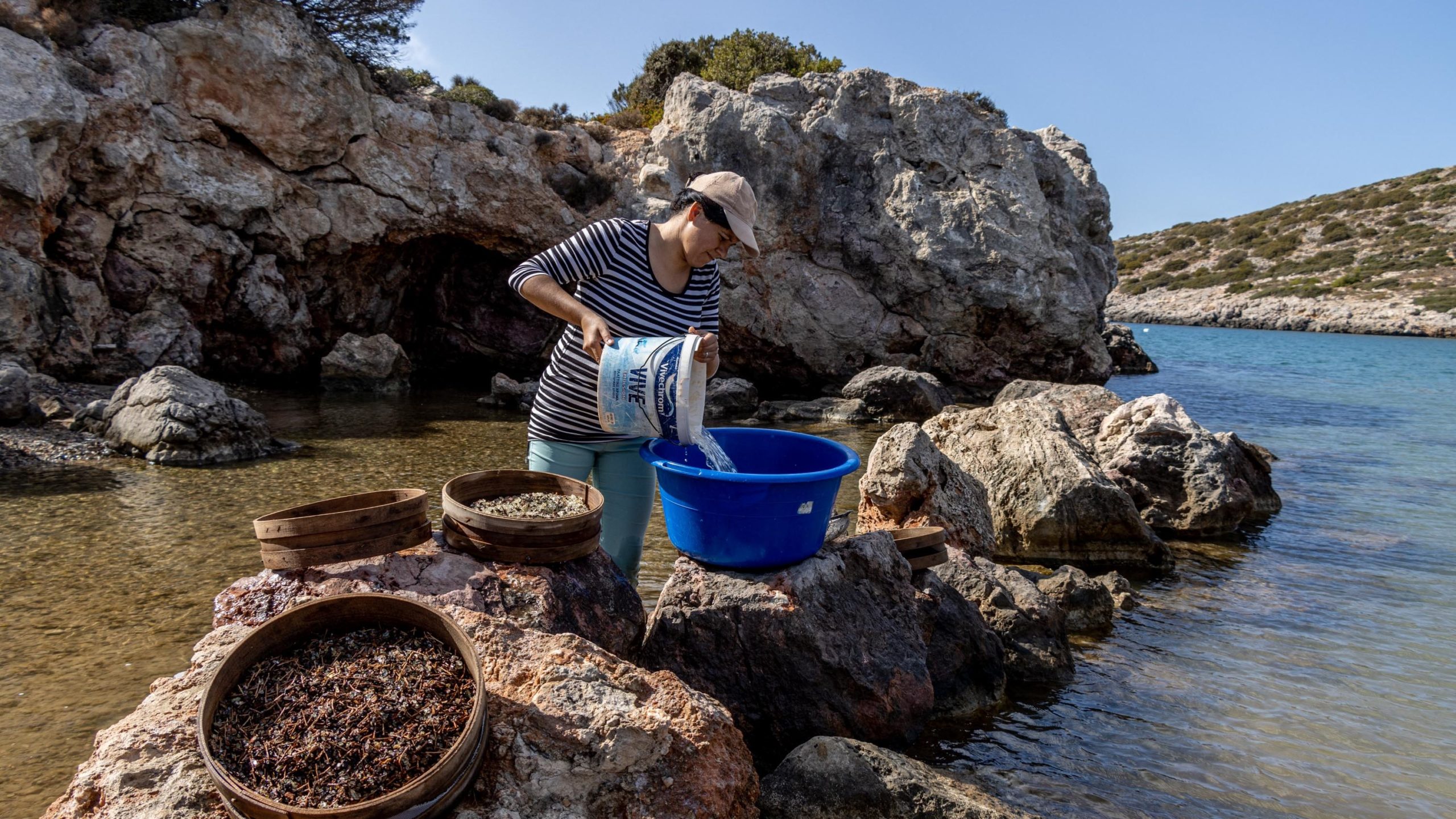
Climate change threats
On August 15, I woke up early to fetch a cake for my housemate Maria Papanikolaou’s name day and found the ground wet from unseasonable rain. Later, as we celebrated with loukoumades in Olympoi’s central square, an announcement to all mastic producers issued from the village loudspeaker: “Tomorrow afternoon we will gather in the office of the mastic cooperative at 7 p.m. to evaluate which areas and how many trees have suffered damage from today’s rains.”
As the Chios newspaper Astraparis reported, the “torrential rain” across southern Chios on August 15, 25 and 26 “caused great damage to the mastic cultivation.” It came in the middle of the first collection period, as growers were gathering pítes from the trees. As the forecast became clear, producers rushed to collect as much resin as possible before the rain. The spotty showers inundated some fields while barely touching others. Some 20 percent of production was lost.
After the rain, I photographed trees in Pyrgi whose white soil had been washed away. That can create impurities and discoloration in the mastic, reducing its quality. It also adds work for growers, who have to reset the table. When I accompanied Maria Gkanali to the fields, she showed me clumps of mastic she couldn’t collect because they had either turned brown or remained stuck in the dirt after she had swept up the table. “We didn’t have as much damage as others because we embroidered earlier so our mastic had at least 10 days to dry before the rain,” she said. “But those who cut their trees later lost their mastic. It turned to oil and was ruined.” Production is insured, so growers whose fields were affected could submit damage claims.
Wildfires are another major threat to mastic cultivation. In August 2012, approximately 40 percent of the region’s mastic trees burned during a widespread fire in southern Chios. In 2016, another fire devastated up to 90 percent of the mastic trees in the southwestern villages of Lithi, Elata and Vessa. Even today, while driving through those villages, you can see the charred trunks of pine and schínos trees on the hillsides. Kostas and Maria were among many who lost trees, but they regenerated some 85 percent from hardy roots, and most are now back in production.
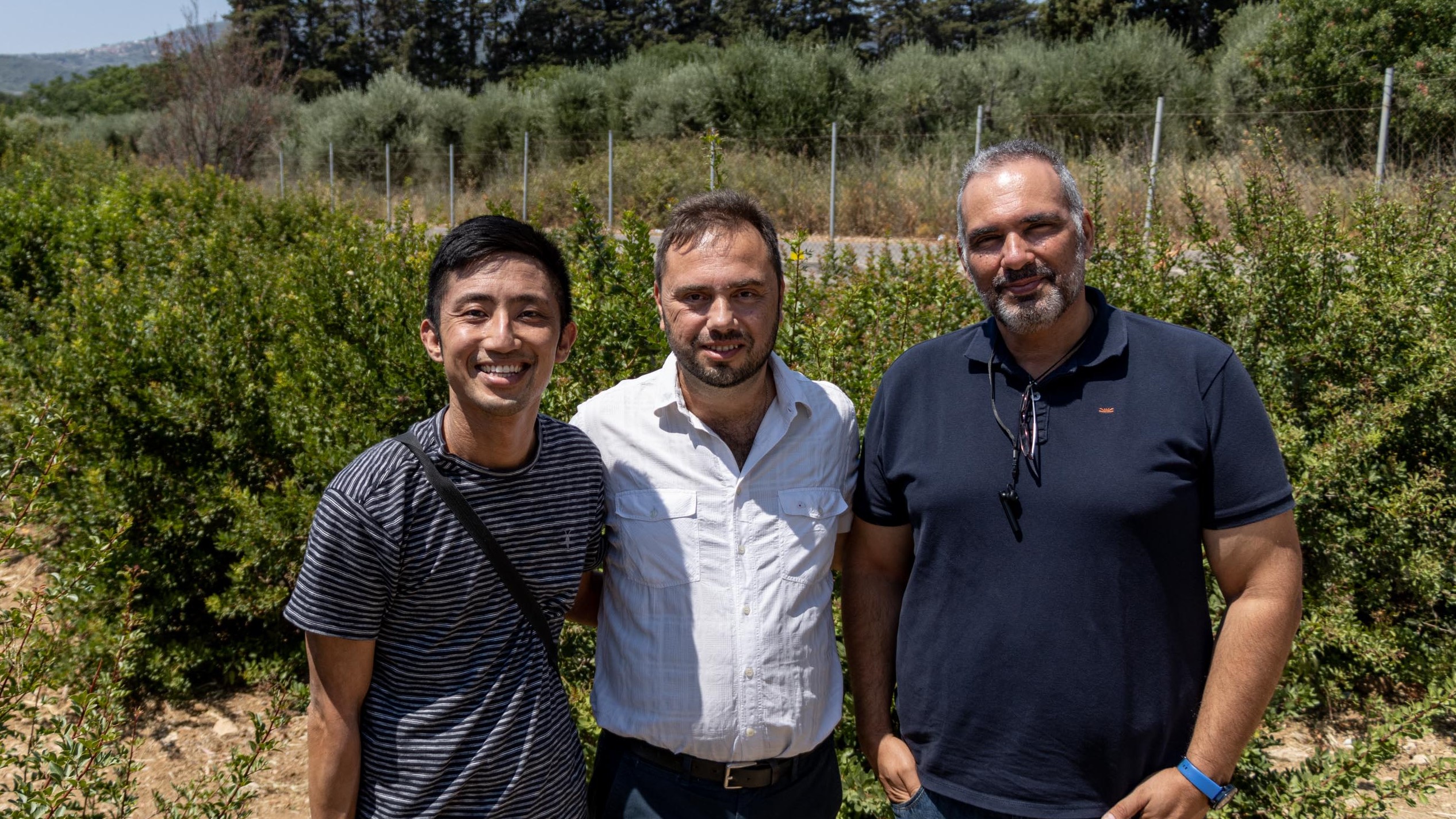
At the Chios Gum Mastic Growers Association factory and greenhouse in Kardamada, I spoke with Dr. Ilias Smyrnioudis, general manager and head of research and development, about some of the extreme weather phenomena he’s witnessed in recent years. “Last year was the first time we saw temperatures over 40 degrees Celsius for more than 15 days,” Smyrnioudis told me. He was a tall, soft-spoken man with deep-set eyes and patches of white in his beard. “These high temperatures stress the tree, and it stops producing and goes into a kind of hibernation to protect itself from losing water.” The intense heat resulted in a lower than expected yield last year.
The association has taken steps to prevent future fires. It supports volunteer firefighters on the island and provides them with equipment. It is also implementing a camera and sensor system in collaboration with Vodafone to monitor temperatures, quickly identify fires and alert authorities.
Empowering the next generation of mastic growers
With mastic demand consistently exceeding supply and the price of resin rising 25 euros per kilo in the last seven years, young people have been drawn back to family plantations from Athens and elsewhere. “More than 20 percent of our growers now are young people who came into the cultivation in the last three, four, five years,” Smyrnioudis told me. “And I believe this number will increase year by year because it gives you a very good income compared to other jobs.” Financial incentives have motivated growers to plant and cultivate more trees. Production surpassed 215 tons in 2021 and 2022, and he expects they will reach 300 tons in a few years.
In mid-July, I visited the association’s greenhouse in Kardamada to observe a training session on modern propagation techniques offered to 48 professional mastic growers from all 24 villages of Mastichochoria. The seminar is part of a program offered by the association in partnership with the agrifood organization New Agriculture for a New Generation and professors from Aristotle University of Thessaloniki’s School of Agriculture. Its goal is to teach producers to create contemporary schínos plantations to meet demand and replace aging trees. The growers will receive 120 training hours in genetics, crop nutrition, fertilization and cultivation, with the hope they will disseminate the new knowledge within their villages.
Smyrnioudis highlighted the importance of investing in the seminars. “Education is a major pillar of development for growers, management, the whole association,” he told me. Lessons in mastic tree physiology explain the reasons behind the “know-how” passed down by growers’ parents and grandparents. Meanwhile, new technologies help producers improve their crops. Both Maria Gkanali and Giota Giannouri, whose fields I visited, participate in the training program.
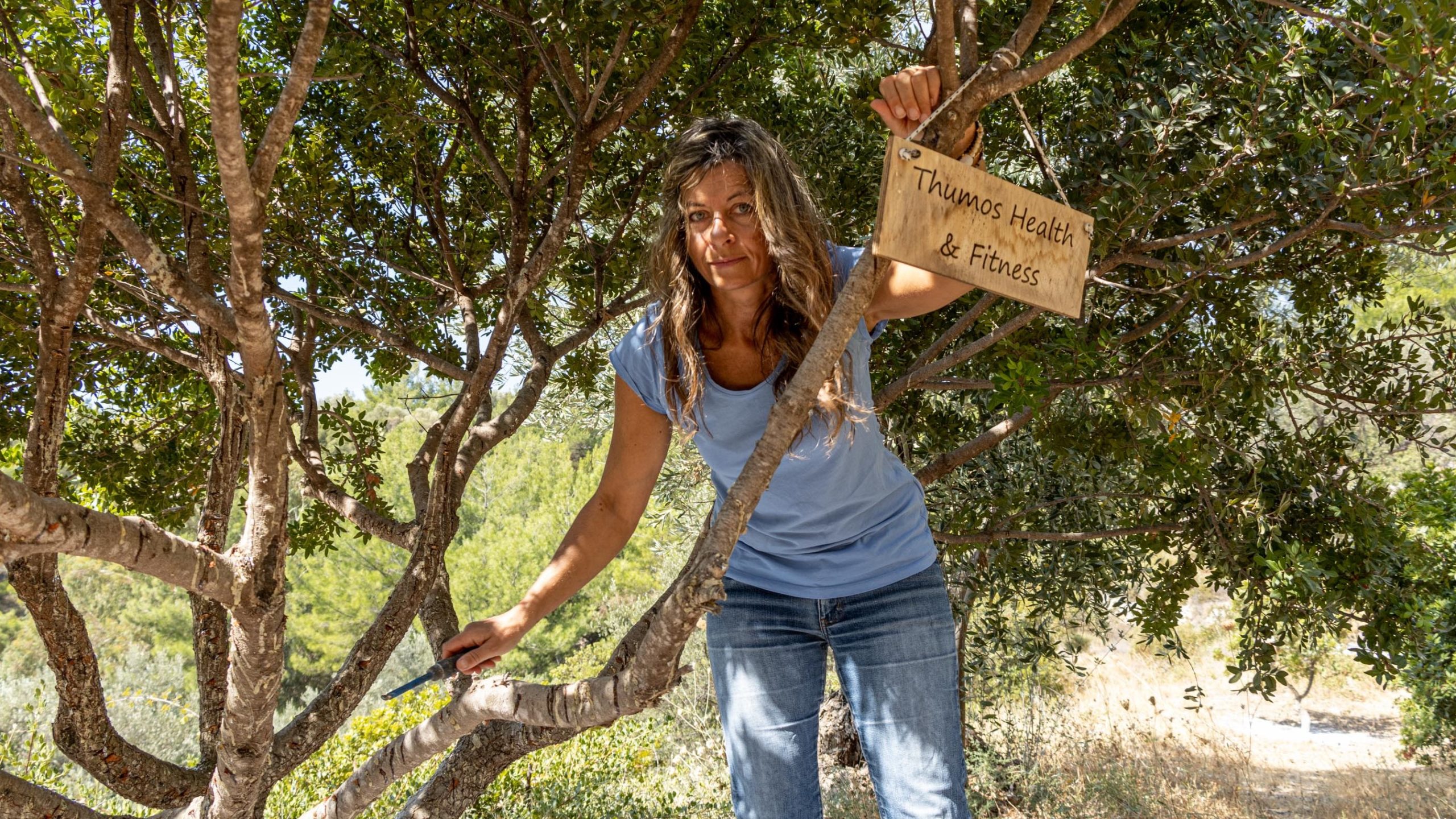
That day at the greenhouse, producers learned two new propagation methods using their own plant material. It was a topic of great interest since many wanted to expand their fields. The traditional grafting method involves bending a branch from a productive older tree to the ground, holding it down with a rock until it reaches the desired spot three to five meters away, covering it with dirt until it develops roots and then severing it from the mother plant. The technique is slow and not suitable for mass production, however, since it requires the old and new trees to be close.
By contrast, one of the new techniques involves rooting small branch cuttings from the producers’ own trees in the association greenhouse. That allows for mass propagation, although only 40 to 45 percent of the cuttings develop roots. I watched producers check the progress of their cuttings and move those that had formed roots to larger containers. It would be at least two years before they could transfer them to the fields.
The second propagation method, called air layering, is faster than branch cuttings and requires less equipment but produces fewer new trees. With this technique, growers peel away a strip of bark from the branch of a mastic tree and paint it with rooting hormone. They wrap a plastic bag around the exposed strip and fill it with soil, tying it on both ends so it looks like a big piece of candy. After six to eight months, new roots grow from the cut, filling the bag. The branch can then be cut from the tree and planted. Maria has planted 30 new trees using this method.
Assistant Professor Stefanos Hatzilazarou from the Aristotle University of Thessaloniki Lab of Floriculture led the seminar. He specializes in propagation and fertilization and has collaborated with the association for 15 years. He told me that an important benefit of the new techniques is that growers can propagate from their own plant material, preserving the trees’ biodiversity and protecting them from disease. He believed the mastic varieties could also help insulate production from the effects of climate change.
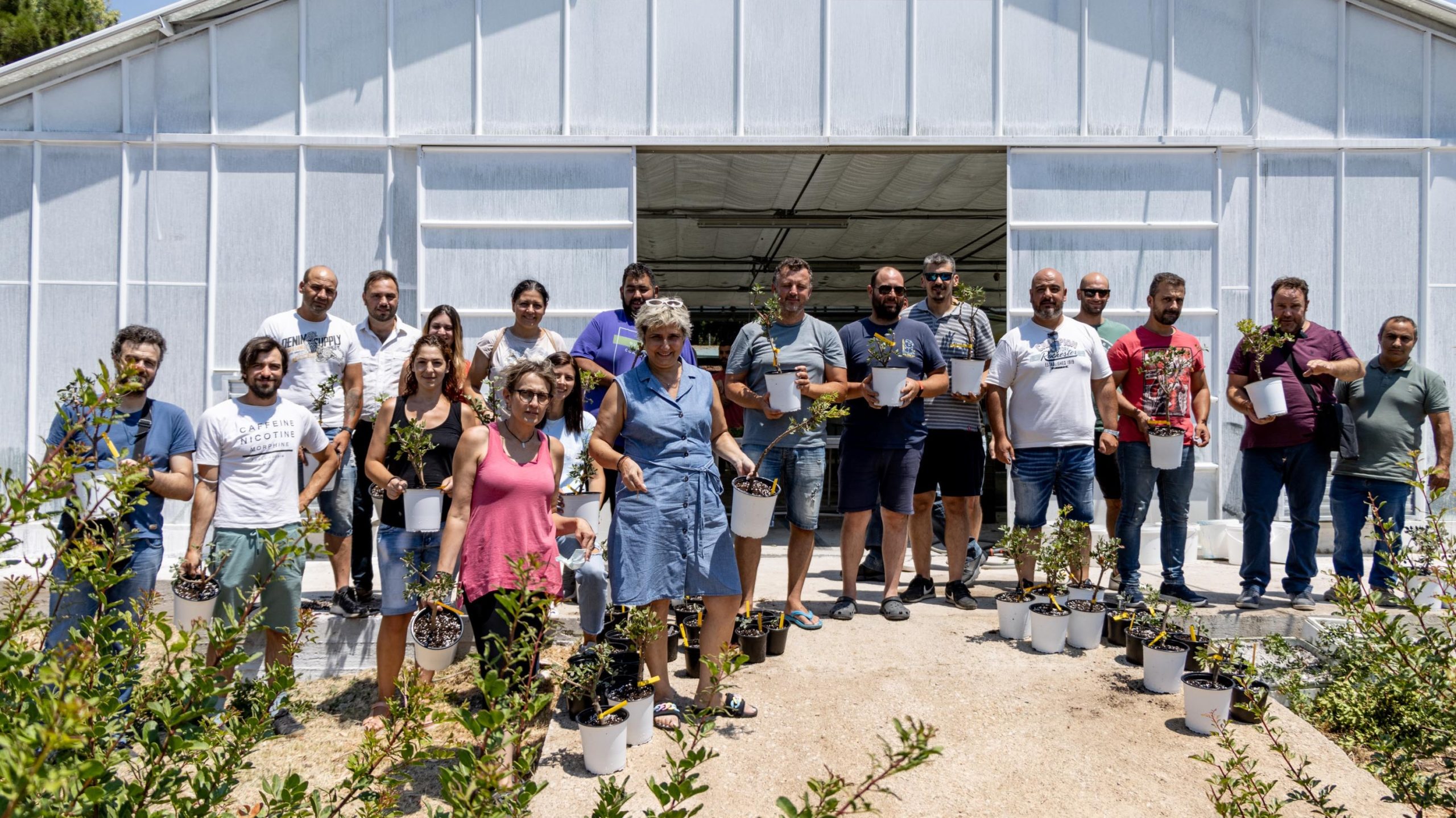
Sharing the experience of mastic production
In Mesa Didima, the village where Dimos Avdeliodis filmed The Tree We Hurt, his cousin Lenia Ziglaki, founder and CEO of the project Adopt Chios Trees, has developed a way to share the experience of cultivating mastic with people around the world. After a professional career as an architectural draftswoman, Lenia decided to return to her roots, tending the family’s mastic and olive trees. While working in the fields, she envisioned how people outside Chios might learn about the difficult process of producing this rare resin. “When a person holds mastic in their hands, behind each drop is a lot of effort and a lot of work,” she told me. “I wanted to share that, to enable people to adopt mastic trees and become partial producers.”
When you adopt a tree through Lenia’s website, a wooden sign bearing a name of your choice is hung on the tree for a year. You receive a certificate of adoption, a photo and a branch from your tree and 50 grams of mastic, roughly a third of the tree’s annual yield. Throughout the year, Lenia emails you updates about each stage of the cultivation process as well as information about the island’s customs and traditions.
So far, people from 23 countries have adopted trees. Walking with Lenia through a field of schínos whose names were written in English, Greek, Spanish, Italian, French, German, Dutch, Arabic and Korean felt like visiting the mastic equivalent of the United Nations, a reflection of the countries familiar with mastic but also a reminder of the island’s international reach. I soon learned that behind each adoption, each name, was a story. Lenia told me that the first person to adopt a tree was a Spanish food technologist who named the tree after her hometown.
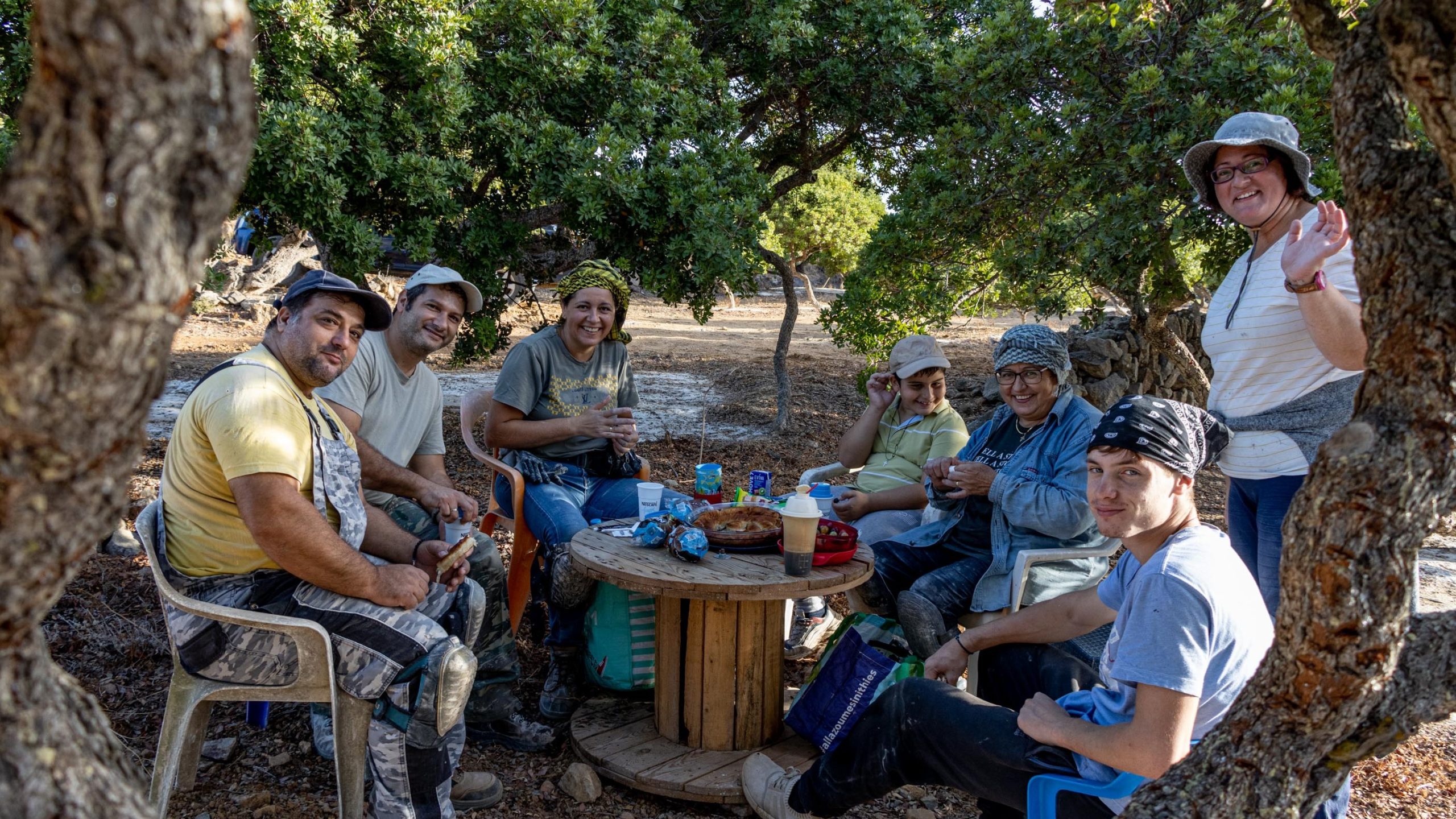
People have adopted trees as gifts for birthdays, name days and anniversaries. A Greek-American woman adopted three trees: one for herself, one for her cousin in Piraeus, and another for her cousin in France. The three trees stand together and are called Mastic Sisters. Then there was a Greek-Belgian woman who adopted a tree for a couple who had recently lost a child. She gave the tree the child’s name, a moving gesture connecting the two beings. It seemed the perfect expression of the Greek condolence, Na zísete na ton thimáste, “May you live to remember him.” The gift also reminded me of the migrant cemetery I visited in Evros, where a cypress tree marked the grave of an Iranian woman who died trying to cross into Europe.
More than mastic fields, Lenia nurtures fields of stories, strengthening people’s connections to Chios and nature. At the same time, Adopt Chios Trees highlights and preserves a unique tradition that spans the centuries and is central to the island’s identity. The sustainable project links schínos trees to human lives, events and emotions. And isn’t that the way it’s always been?
Here’s my favorite memory from the summer harvest: after a few hours scraping 200-year-old mastic trees, we all put down our tools and gathered around a wooden table in Maria’s family field for breakfast. Over a feast of spanakopita, toast, coffee, juice, jam-filled croissants and homegrown grapes, three generations of Maria’s family roared with laughter as our mismatched plastic chairs broke one after another. The trees protected us from the sun and the sweet smell of resin filled the air. The meal felt so intimate, as though we were eating not merely among the trees but with them. I pictured Maria sitting at this table as a girl, and just as clearly, I could imagine her children here in a few summers, when the trees she planted begin to weep.
Top photo: Christos Demiris spreads a white calcium carbonate powder under each tree, which helps to solidify and polish the mastic tears without affecting their quality

